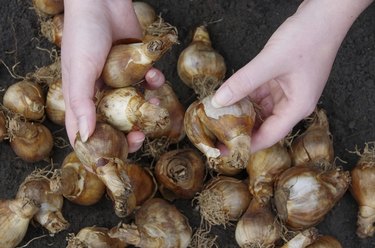
Tulip bulbs (Tulipa spp.) need from four to six weeks for their roots to develop before the first expected frost. The best time to plant tulip bulbs in Minnesota is generally in early September, but the arrival of autumn frost varies in different parts of the state. Although you can plant tulip bulbs until the ground freezes, they'll do better if you plant them early enough to grow some roots before the first hard frost. Minnesota is within U.S. Department of Agriculture plant hardiness zones 3a through 5a.
First Frost in Minnesota
Video of the Day
You know the weather where you live. For example, as a general rule, you can expect the first frost to arrive in Saint Cloud in northern Minnesota from September 21 to September 30; in Bloomington, Mankato, Minneapolis, St. Paul and Rochester in central and southern Minnesota between October 1 and October 10; and in Duluth on the shores of Lake Superior from October 11 to October 20. If you plant tulips too early in September and you have a mild, sunny October, they may push out of the ground when the weather forecaster is calling for snow.
Video of the Day
Location and Soil Preparation
Plant tulips in well-draining organic soil in full sun. Tulips grow best in soil with a pH of 6 or 7. Because cold air flows downhill, they will bloom earlier on a hill than in a valley. Tulips will bloom earlier if you plant them on a south slope.
If you have heavy clay soil, work peat moss or compost into the top 12 to 18 inches before planting. If you want your tulips to last for more than a year, mix 2 cups of bonemeal plus 5 tablespoons of 10-10-10 fertilizer for a 10-square-foot area. For a larger area, mix 2 pounds of 5-10-5 fertilizer into 100 square feet. Add the bonemeal and fertilizer at the same depth as the soil amendment. The bonemeal contains phosphorus that helps the bulbs develop roots.
Planting the Bulbs
Tulips look best planted in groups rather than a single line. If you have heavy, clay soil, plant tulip bulbs twice as deep as they are high. If you have sandy soil, plant them three times as deep as they are high. Depending on your soil, you might plant larger bulbs 8 to 10 inches deep. Plant small bulbs 4 to 6 inches apart and larger bulbs 6 to 9 inches from one another.
After you plant the bulbs, cover them with 2 to 3 inches of shredded bark or other organic mulch, and water them to give them a boost.
Species Tulips for Minnesota
Deb Brown, a former extension horticulturist with the University of Minnesota, writing in the Minneapolis Star-Tribune, recommends species tulips for Minnesota's cold climate, which include cultivars, species and varieties that resemble their wild relatives. Species tulip plants are shorter than hybrids and the flowers are smaller, though certain bulbs produce several flowers at the same time. When planted in clusters, they pack a punch in gardens with their vibrant colors. In Minnesota's cold winters, flowers of hybrid tulips lose color and size in their second year of blooming. They may fail to bloom at all in year three or four and require replacing. Plant species tulip bulbs 4 to 5 inches deep at the same time as hybrid cultivars.
Turkestan tulip (Tulipa turkestanica) yields creamy white to yellow flowers, and will grow in USDA zones 3a through 9b. Turkish tulip (Tulipa acuminata) yields grows red, yellow-orange and gold flowers and also grows in USDA zones 3a through 9b. Tarda tulip (Tulipa tarda) yields creamy white to yellow flowers in USDA zones 4a through 7b.
- University of Minnesota Extension: Plant Those Fall Bulbs Now
- Renegade Gardener: Go Wild With Fall Bulbs
- Minneapolis Star-Tribune: Time-Tested Tulips
- Missouri Botanical Garden: Flowering Bulbs
- University of Illinois: Bulbs & More Planting and Care
- North Dakota State University Cass County Extension: Spring Flowering Bulbs
- Zipcodezoo: Tulipa Turkestanica
- Zipcodezoo: Tulipa Acuminata
- Zipcodezoo: Tulipa Tarda
- PlantMaps: Minnesota First Frost Date
- University of Minnesota: Median Dates of Critical Low Temperature Thresholds in Minnesota